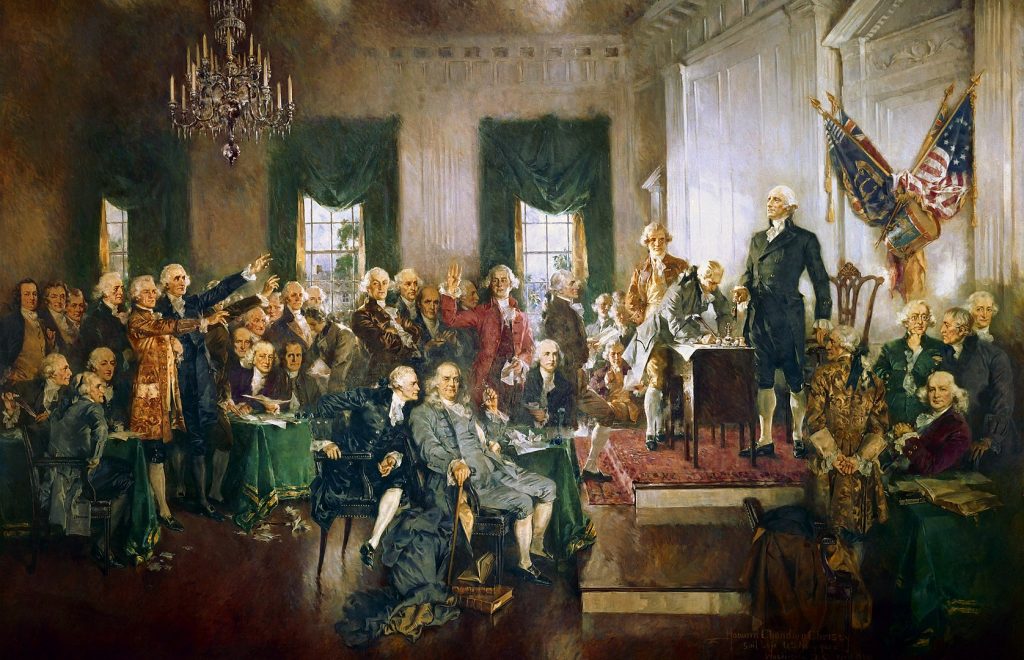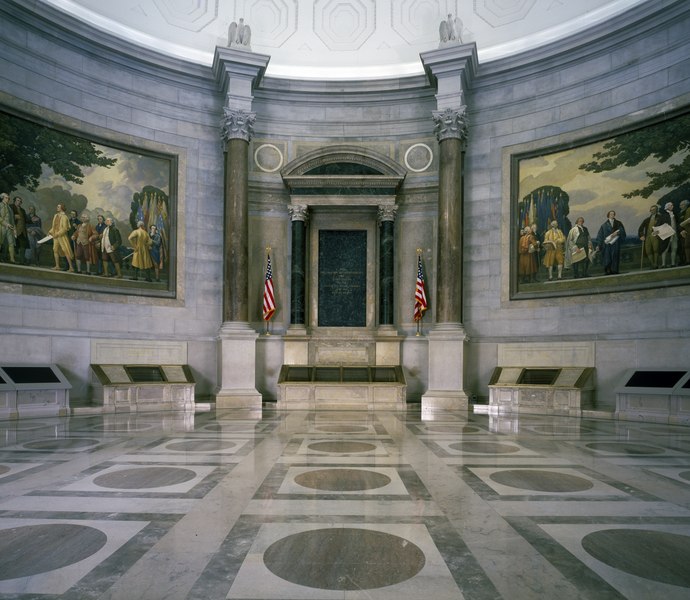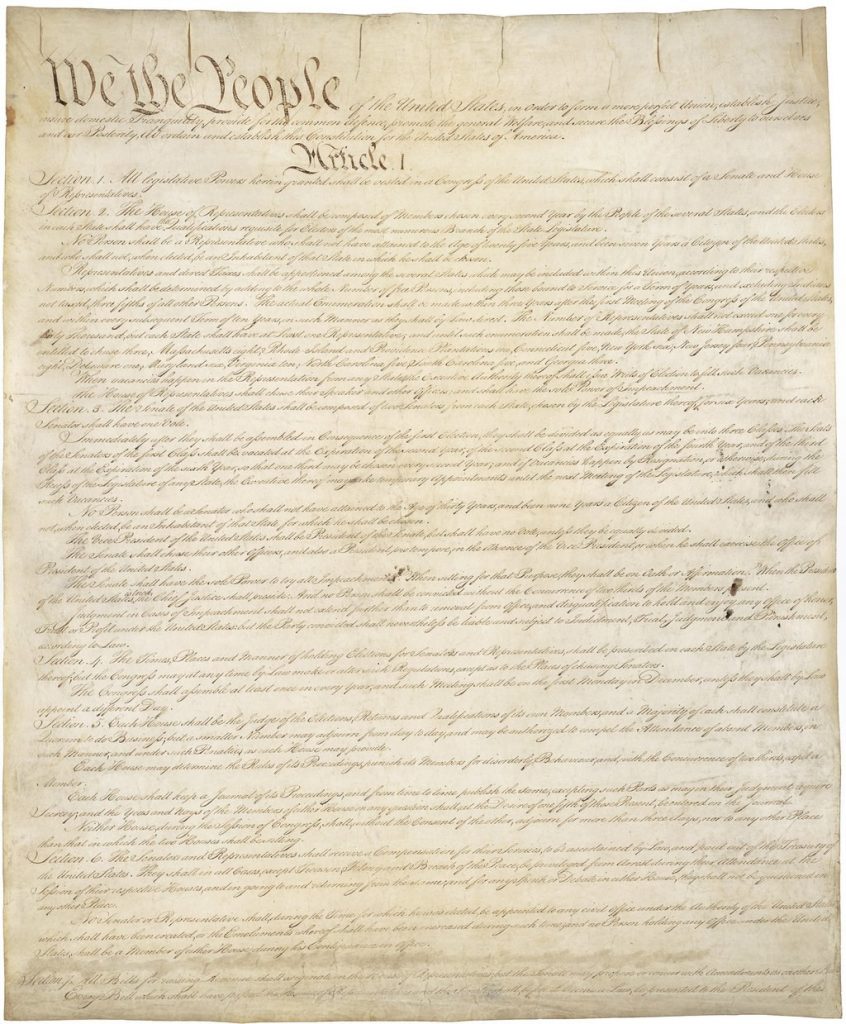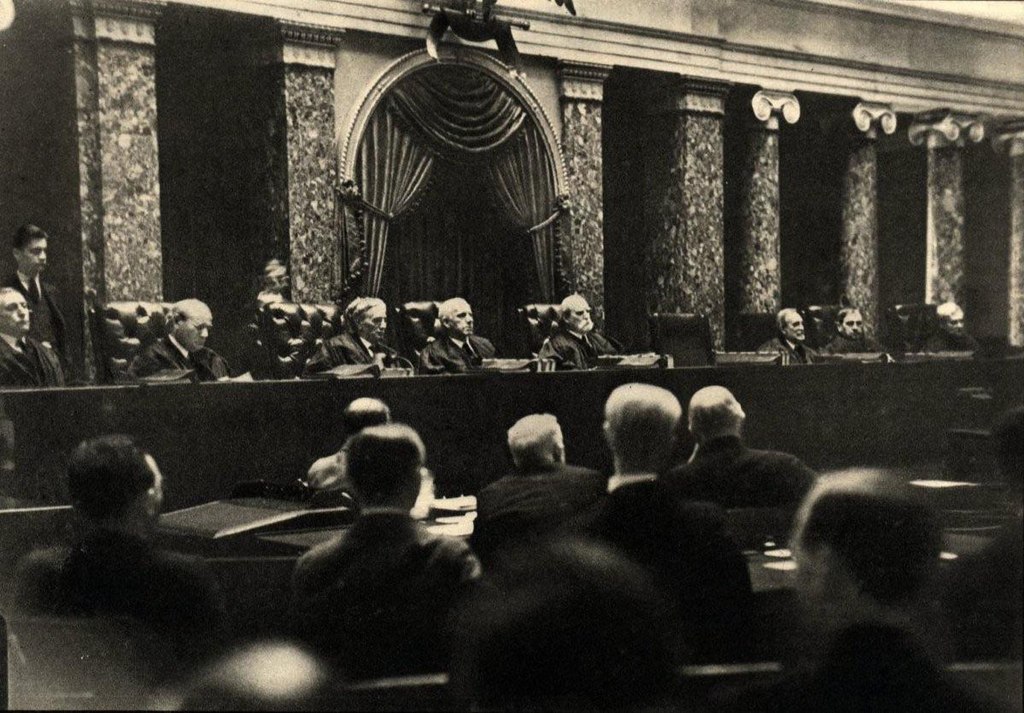The American creed
The veneration of the US constitution is directly connected to America’s emergence as global hegemon. As the US’s democratic dysfunctions become ever more apparent, this culture is coming under strain. Why the end of the American Century coincides with the collapse of the country’s constitutional consensus.
In the last two centuries, 220 countries have appeared on the global stage and, between them, they have produced a remarkable 900 written constitutions. The sheer numbers are telling: for the most part, societies treat their constitutions instrumentally. When these legal-political orders break down or social upheaval brings new elites and alliances to power, old texts often are jettisoned, and new ones written.
But this is not how most Americans treat their federal constitution. If you grew up in the United States around the turn of the twenty-first century, you might well have assumed, instead, that the American constitutional system stood at the apex of liberal democratic ideals.
The constitution itself inspires almost religious devotion. Politicians of every party routinely praise its genius. This eighteenth-century document, so the argument goes, highlights how the US from the founding has been engaged in what Barack Obama called ‘an improbable experiment in democracy’ grounded on principles of equality, self-government and personal liberty. It is the key to what makes America ‘exceptional’, the foundation of our ‘shining city on a hill’ and the reason the country offers a universal model of what Abraham Lincoln called ‘government of the people, by the people, for the people’.
Such a culture of veneration is especially jarring today given the US’s obvious anti-democratic dysfunctions: presidents elected with a minority of votes; a national Senate that gives vastly more power to voters in Wyoming than California; a Supreme Court that treats private corporations as persons with rights.
The American system has long been characterized by the proliferation of corporate money and by checks on popular authority – from the Senate to gerrymandering in the House of Representatives, to the blocked constitutional amendment route, and from widespread practices of voter disenfranchisement to the distortions of the judicial appointments process and the dramatic power that a small coterie of lifetime federal judges exercises over legal-political life.
All of this has made it increasingly apparent that, rather than reflecting actual mass sentiment, the federal constitution at best promotes paralysis. At worst, it entrenches the interests of a wealthy and white minority coalition within the Republican party, a coalition that enjoys a veto power well beyond its actual public support.
Given its manifest flaws, how did Americans come to revere this written document as nearly perfect?

Signing of the United States Constitution with George Washington, Benjamin Franklin, and Alexander Hamilton (left to right in the foreground). Painting Howard Chandler Christy. Source: Wikimedia Commons
The most common answer from scholars has been that constitutional veneration has always existed in American culture and politics, or at least since the early nineteenth century. But as I argue in a forthcoming book, this answer obscures more than it reveals.
For starters, while a small range of notables and national elites in the early history looked upon the constitution with real attachment – it helped them make sense of their relationships to the founding and their role in preserving a national project – for most individuals the federal government’s constitution had only a marginal daily effect throughout most of the nation’s initial years.
The driving activity of social cohesion in the nineteenth century was territorial settlement, which generated what historian Robert Wiebe famously called a ‘society of island communities’. Given the decentralized nature of expansion and of resulting institutional power, the heart of political and economic life lay at the local level and not with the intricate and remote structure of federal policymaking in Washington, D.C.
In fact, throughout the nineteenth century the constitution was only haphazardly taught at any level of education. Even law schools did not treat it as an important focus of study. Before the 1920s and 1930s, constitutional law was almost always an optional upper-level course, if it was offered at all. Indeed, it was rare that a law scholar with a major public profile focused primarily on the federal constitution.
Just as significantly, what some early notables embraced about the federal constitution and what by contrast Americans today venerate is wildly different. The constitution now is inexorably joined to what Swedish sociologist Gunnar Myrdal labeled the ‘American creed’ – a vision of the US as standing for the promise of equal liberty for all. But as recently as 1900, only a small number of white Americans would have recognized their own country in this story. A far more common framing, embraced by Teddy Roosevelt and Frederick Jackson Turner, revolved again around what Roosevelt called ‘the winning of the west’: Anglo-European continental conquest and settlement.
To the extent that the federal constitution was worth defending, nineteenth century politicians frequently memorialized the document as a compromise. As Massachusetts Senator Daniel Webster contended, the system was a détente between North and South over the matter of slavery that – according to this account – strengthened neither side in particular, but created the possibility of a vibrant and geographically expansive political union.
Men like Webster considered such compromise ethically legitimate because it ensured the nation’s existence; it embodied the necessary political cost of promoting shared goals of prosperity, independence, and territorial growth – goals vital regardless of region.
But for most Americans today, any national narrative built around the acceptance of slavery would be regarded as deeply immoral – the very antithesis of the current climate of veneration.
Just as disorienting from a twenty-first century perspective, by 1900 a driving conversation around the constitution focused on how ill-equipped the text had become for serving as the governing framework of the republic, one that most Americans again assumed to be racially-restrictive. The civil war had underscored the explicit failures of that founding compromise. The effects of industrialization and resulting class conflict also raised fundamental issues about the legitimacy of the prevailing order. The federal constitutional system’s endless veto points made it nearly impossible for the poor to use elections to better their lot, while business elites wielded outsized power at virtually every level of government.
For many individuals living at that time, it would have been far more likely to imagine the constitution being replaced with a new one than to conceive of a twenty-first century America that deifies the old text as somehow embodying inherent and founding commitments to Myrdal’s ‘creed’.

The National Archive in Washington D.C., where the US Constitution is displayed. Photo by Carol M. Highsmith. Source: Wikimedia Commons
How did the meaning and conversation around the constitution change so dramatically? One consequence of the cultural power of narratives of American exceptionalism and national greatness is that not only are such questions rarely asked, but the answers are almost always sought internally. Since the US is so distinctive, its development, some assume, cannot be a product of international processes and comparative practices.
In truth, however, the modern veneration of the federal constitution is directly related to the US’s rise from regional power to the world’s dominant global force, in the context especially of World War II, international decolonization and Cold War conflict.
By the mid-twentieth century, an American nationalist faith had crystallized around a series of essential commitments: to market capitalism, to representative democracy, to racial equality, to the protection of individual liberties, and – crucially – to the belief that these principles grounded the US’s legitimate right to exercise an international police power wherever it saw fit.
On the face of it, these were disparate ends, which need not go together and might well be in profound tension. But the narrative that American politicians and commentators developed around the federal constitution served a critical role in cohering these ends into a single American ideology. The 1787 document became synonymous with America’s ideal form of government, the normative core of what magazine magnate Henry Luce famously dubbed the ‘American Century’.

Photo by U.S. National Archives and Records Administration. Source: Wikimedia Commons
Central to this transformation in the significance of the federal constitution was America’s claim to offer a universal model for constitution-writing, conceived of as a foundational activity in the initial construction of a self-controlling and self-representing polity.
And it’s certainly true that in 1789, when the United States adopted its federal constitution, projects of explicit constitution-writing were historical anomalies. The relative novelty of the American example created a domestic and international connection between the country and the practice of drafting constitutions. This link was further reinforced by the process by which US territories acceded to statehood. The transformation of Indigenous land into a state began with the demographic removal of Native peoples and then settlement by Anglo-Europeans, after which settlers would write and formally adopt a new constitution before seeking admission.
In this way, constitution-writing became a key marker in the process of westward expansion and the accepted precondition for recognition as equal, self-governing ‘sister’ states. By the mid-nineteenth century, constitution-making had spread as a defining political experience in the lives of many of its white male citizens – even as virtually all the state constitutions rested on the exclusion of Native peoples, of women and Black persons, whether enslaved or formally ‘free’.
During the same period, especially in the wake of the European revolutionary upheavals of 1848, constitution writing also increasingly amounted to an almost automatic political act for new countries. It then proliferated globally precisely through the slow disintegration of the imperial model and with the emergence of newly independent nation-states.
Indeed, constitution writing occurred especially during particular ‘global waves’: after the European uprisings of 1848; after the Great War; after World War II triggered a global process of decolonization; and in 1989, after the fall of the Soviet Union.
In all these eras of constitution-writing, nationalist elites sought both to establish independence from past imperial rulers and to assert the equal and sovereign status of their polities vis-à-vis other major powers and state formations. Therefore, written constitutions emerged as a key institutional and symbolic mechanism serving multiple related ends.
For internal audiences, the documents codified both political rupture with the old empire as well as the principles of the new polity. On the international stage, they allowed nationalist leaders, especially in the decolonizing Global South, to assert equal sovereign statehood and to illustrate to European audiences the genuinely ‘modern’ nature of their political projects. Thus, the global rise of constitutions was inextricably bound to the long historical narrative of imperial break-up, beginning with the eighteenth-century fracture of British dominion in North America and continuing all way to the post-World War II anti-colonial struggles across Asia and Africa.
In a world in which the challenges and needs of new polities moved to the forefront of global discussions, American elites came to understand and to position the US as the original constitutional, anti-imperial paradigm – the first among equals, both temporally and substantively.
By idealizing the federal constitution and America’s long tradition of state constitution writing, American politicians and commentators – starting in places like the Philippines and Puerto Rico and then intensifying during the two world wars – tried to draw a sharp line between the legitimacy of twentieth century American global dominance and the illegitimacy of the old imperial orders. Indeed, during World War I such arguments played a meaningful role in Woodrow Wilson’s own shift in orientation to the constitution, from an earlier sceptic to the presidential overseer of a security apparatus, which criminalized socialist and anti-war critiques of the constitution as seditious speech.
By World War II, American leaders fully intertwined Americanism and constitutionalism, contending that the US, in line with Wilsonian thinking, sought to forge a world safe for democracy, rather than to pursue extraction and conquest. The US federal constitution served as tangible evidence of this fact – as a document that preserved freedoms at home and whose principles could be exported abroad for stable and prosperous development overseas.
Whenever the United States intervened militarily abroad, or imposed its economic and political might, it asserted its good intentions, its wish to create a stable and self-governing world of liberal constitutional states. Constitutionalism provided both an ideological basis for international arrangements under American supervision as well as the model for how foreign states should themselves be domestically structured. For this reason, officials contended, it was inappropriate to compare the US to other empires, because America’s interests were effectively the same as the world’s interests.
Of course, many countries have embedded their global projections of power in narratives of singular destiny. The American language of its own exceptionalism vis-à-vis other empires placed US foreign policymakers in a long line of past European imperial officials, who had also justified their nations’ global authority with claims of special historic mission and of the unusual gifts that they alone could offer the world.
But the unique American fusion of this inclusive narrative with constitutionalism had real resonance globally, shaped as it was by the particular international discourses and structural changes of the early to mid-twentieth century. At the same time, the narrative was sufficiently flexible to respond to domestic social struggles, especially over race. Cold War-era Supreme Court decisions like Brown v. Board of Education, declaring ‘separate but equal’ inherently unequal, reinforced domestic associations of the constitution and the Supreme Court with key civil liberties and civil rights victories, as well as with the consolidating national story.
Equally significant, the historical contingencies of the mid-twentieth century – for instance the strength of the labour movement – created supermajorities across national institutions behind a New Deal and the post-war political settlement, which defused class conflict and entrenched a limited social welfare state. Such developments at home, however exceptional within the context of the long American history, calmed real reformist worries as late as the 1930s that the constitutional order was perhaps an immovable roadblock to even minor improvements. Over time, these international and domestic factors fostered a romance around the constitution, a heartfelt and genuine belief among politicians and many citizens in the American system’s genius and centrality to the promotion of liberty everywhere.

A photo of the United States Supreme Court by Erich Salomon. Salomon faked a broken arm and hid the camera in his cast. Photo by Erich Salomon. Source: Wikimedia Commons
For all the real benefits of the mid-century constitutional culture, today’s conditions nonetheless speak to how the rise of veneration has also undermined efforts to seriously question the text’s many limitations.
As someone who teaches constitutional law every fall to first-year students I have been struck by the disconnect between the traditional course – with its focus on what judges think and do – and the endemic problems with the overarching order, as laid bare by unfolding institutional and social crises. This is because the field – including much of what counts as constitutional scholarship and is taught in the classroom – has been deeply shaped by the same mid-century romance of the constitution and its relation to the American project. As historian Mark Graber notes, whatever the limited salience of the federal constitution in earlier periods, by the second half of the twentieth century, ‘Legal luminaries … [were] best known for their constitutional analysis’ with ‘virtually all law professors with any name recognition outside of law … scholars of the constitution’. Not coincidentally, constitutional law professors who came of age during and after the early Cold War tended to take for granted the existing terms and overall legitimacy of both America’s federal constitution and of the American global project.
Even more specifically, to study the constitution became to participate in a shared conversation with federal judges, the institutional embodiments of the larger constitutional system. And to the extent that scholarship took its lead from what judges wrote and cared about, it was hardly a surprise that the boundaries of debate narrowed.
All of these judges, whether ostensibly liberal or conservative, are members of a particular governing elite, which by training and professional acculturation has been deeply invested in the existing constitutional state, whatever that state’s evident flaws.
Certainly, there are profound differences in how liberal as opposed to conservative judges often venerate the constitution, with consequences for contemporary politics. One side emphasizes the idea of a flexible document able to incorporate projects of inclusive reform, in the process fulfilling an historic creedal promise. The other side presses back by calling for a return to what the framers may have intended and the importance of implementing their perceived original will across the contemporary social, economic and political landscape.
Yet, in a deep sense both judicial positions – and the larger legal-political camps that they inhabit – stand on the other side of a massive historical chasm. In the early twentieth century, it was commonplace for Socialists and Progressives to see the governing structure as inherently undemocratic and to place blame on the framers themselves for creating a social order grounded in class rule and protective of slavery. Mid-century transformations fundamentally recast the conversation around both the founding and the constitution’s legacy, cloaking those eighteenth-century framers in much later ideas about equality or anti-totalitarian civil liberties.
Indeed, one might argue that the rise of a Cold War and liberal politics of constitution worship – with the text expressing a redemptive national mission – created the ideological space for the emergence of a new, growing conservative legal and political project.
For legal conservatives beginning in the 1970s, wary of changes to racial and gender hierarchies, a powerful cultural rebuttal to social transformations became to idealize an originalist America, arguing that if the founders were so wise why not simply return to the world that they intended. But for all the meaningful conflicts within the judicial elite, precisely because all sides more or less accepted the wisdom of the founding design, deeper structural flaws were excised from public debate. Whether living constitutionalist or originalist, all were institutional players who had drunk deeply from the well of US exceptionalism and whose activity involved an imposition of that state’s broader ideological will, grounded in the terms of the ‘American Century’.
Both the legitimacy of that century and of the American constitutional model are facing profound pressure today. Given how entangled the two are, it makes sense that just as they emerged together, they are simultaneously breaking down.
But the persistence of a culture of constitutional veneration creates an upside-down world in the United States, in which for decades individuals have been conditioned to hold up an increasingly dysfunctional system as an ideal-typical embodiment of democratic possibility and to seek to replicate it everywhere. At the same time, the central repositories of constitutional expertise have, until very recently, spent surprisingly little time questioning the overall narratives and frameworks or where they came from.
It is time, definitively, to turn the page, both on the story of American exceptionalism, and on the continuing embrace of an order that has proven ill-suited for a collective project aimed at equal and effective freedom. This requires a forthright confrontation – in politics and in the academy – with the constitutional culture forged during the American Century.
It also requires facing squarely the reality that the US is not now and has never been a genuine democracy, and that the only pathway out of our current malaise is to reconstruct shared state and economic institutions – including the federal constitution – on truly democratic terms.
This article appears in an upcoming special issue of Public Seminar on new constitutions and constitutional veneration.
Published 8 October 2021
Original in English
First published by Eurozine / Public Seminar
Contributed by Public Seminar © Aziz Rana / Public Seminar / Eurozine
PDF/PRINTNewsletter
Subscribe to know what’s worth thinking about.
Related Articles

Far-right foreign policy in the age of MAGA 2.0
A conversation with Quinn Slobodian
For the US today, tariffs serve the same purpose as bombs. But Trump’s revival of 19th century-style economic imperialism may be alienating his international far-right allies – with one exception: Russia.

Four NGOs in Kharkiv explain what the suspension of USAID funding means for their work. They include a media organization countering Russian propaganda, a centre providing veterans with legal advice, and volunteer groups refurbishing war-damaged buildings.





